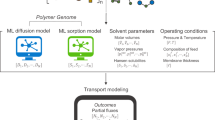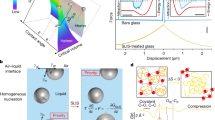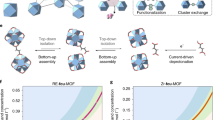Abstract
Membrane technology holds enormous potential for reducing the energy consumption of various separation processes. It is of particular importance for energy-intensive industrial separation processes in organic liquids, such as crude oil fractionation. Most recent developments have focused on identifying ground-breaking materials that provide outstanding stability and rapid separation. However, the sustainability implications of such performance optimizations remain unclear. This Review aims to highlight how membrane technology can drive sustainability and steer industries towards a sustainable future. In particular, it provides perspectives on promising materials, manufacturing processes and industrial applications with respect to energy saving, process intensification and environmental impacts.
This is a preview of subscription content, access via your institution
Access options
Access Nature and 54 other Nature Portfolio journals
Get Nature+, our best-value online-access subscription
27,99 € / 30 days
cancel any time
Subscribe to this journal
Receive 12 digital issues and online access to articles
118,99 € per year
only 9,92 € per issue
Buy this article
- Purchase on SpringerLink
- Instant access to full article PDF
Prices may be subject to local taxes which are calculated during checkout





Similar content being viewed by others
References
Burke, D. W., Jiang, Z., Livingston, A. G. & Dichtel, W. R. 2D covalent organic framework membranes for liquid-phase molecular separations: state of the field, common pitfalls, and future opportunities. Adv. Mater. 36, 2300525 (2024).
Huang, T. et al. Molecularly-porous ultrathin membranes for highly selective organic solvent nanofiltration. Nat. Commun. 11, 5882 (2020).
Li, X. et al. Metal–organic frameworks based membranes for liquid separation. Chem. Soc. Rev. 46, 7124–7144 (2017).
Qian, Q. et al. MOF-based membranes for gas separations. Chem. Rev. 120, 8161–8266 (2020).
Zhang, C. & Koros, W. J. Zeolitic imidazolate framework-enabled membranes: challenges and opportunities. J. Phys. Chem. Lett. 6, 3841–3849 (2015).
Zhang, C., Wu, B. H., Ma, M. Q., Wang, Z. & Xu, Z. K. Ultrathin metal/covalent-organic framework membranes towards ultimate separation. Chem. Soc. Rev. 48, 3811–3841 (2019).
Comesaña-Gándara, B. et al. Redefining the Robeson upper bounds for CO2/CH4 and CO2/N2 separations using a series of ultrapermeable benzotriptycene-based polymers of intrinsic microporosity. Energy Environ. Sci. 12, 2733–2740 (2019).
Kim, S. & Lee, Y. M. Rigid and microporous polymers for gas separation membranes. Prog. Polym. Sci. 43, 1–32 (2015).
Thompson, K. A. et al. N-aryl-linked spirocyclic polymers for membrane separations of complex hydrocarbon mixtures. Science 369, 310–315 (2020).
Chisca, S. et al. Polytriazole membranes with ultrathin tunable selective layer for crude oil fractionation. Science 376, 1105–1110 (2022).
Jiang, Z. et al. Aligned macrocycle pores in ultrathin films for accurate molecular sieving. Nature 609, 58–64 (2022).
He, A. et al. A smart and responsive crystalline porous organic cage membrane with switchable pore apertures for graded molecular sieving. Nat. Mater. 21, 463–470 (2022).
Li, S. et al. Hydrophobic polyamide nanofilms provide rapid transport for crude oil separation. Science 377, 1555–1561 (2022).
Liang, Y. et al. Polyamide nanofiltration membrane with highly uniform sub-nanometre pores for sub-1 Å precision separation. Nat. Commun. 11, 2015 (2020).
Clarke, C. J., Tu, W. C., Levers, O., Brohl, A. & Hallett, J. P. Green and sustainable solvents in chemical processes. Chem. Rev. 118, 747–800 (2018).
Nguyen Thi, H. Y. et al. Closing the sustainable life cycle loop of membrane technology via a cellulose biomass platform. ACS Sustain. Chem. Eng. 10, 2532–2544 (2022).
Razali, M. et al. Sustainable wastewater treatment and recycling in membrane manufacturing. Green. Chem. 17, 5196–5205 (2015).
Hardian, R., Alammar, A., Holtzl, T. & Szekely, G. Fabrication of sustainable organic solvent nanofiltration membranes using cellulose–chitosan biopolymer blends. J. Membr. Sci. 658, 120743 (2022).
Mauter, M. S. et al. The role of nanotechnology in tackling global water challenges. Nat. Sustain. 1, 166–175 (2018).
Sola, I., Zarzo, D. & Sánchez-Lizaso, J. L. Evaluating environmental requirements for the management of brine discharges in Spain. Desalination 471, 114132 (2019).
Sola, I. et al. Review of the management of brine discharges in Spain. Ocean Coast. Manage. 196, 105301 (2020).
da Silva Burgal, J., Peeva, L. & Livingston, A. Negligible ageing in poly(ether–ether–ketone) membranes widens application range for solvent processing. J. Membr. Sci. 525, 48–56 (2017).
Sultan, Z. et al. Membrane fractionation of liquors from lignin-first biorefining. ChemSusChem 12, 1203–1212 (2019).
Koros, W. J. & Lively, R. P. Water and beyond: expanding the spectrum of large-scale energy efficient separation processes. AIChE J. 58, 2624–2633 (2012).
Elimelech, M. & Phillip, W. A. The future of seawater desalination: energy, technology, and the environment. Science 333, 712–717 (2011).
Lin, S. Energy efficiency of desalination: fundamental insights from intuitive interpretation. Environ. Sci. Technol. 54, 76–84 (2020).
Fathizadeh, M., Xu, W. W. L., Zhou, F. L., Yoon, Y. & Yu, M. Graphene oxide: a novel 2-dimensional material in membrane separation for water purification. Adv. Mater. Interfaces 4, 1600918 (2017).
Tang, C. Y., Zhao, Y., Wang, R., Hélix-Nielsen, C. & Fane, A. G. Desalination by biomimetic aquaporin membranes: review of status and prospects. Desalination 308, 34–40 (2013).
Thompson, K. A., Mathias, R., Lively, R. P. & Finn, M. G. Structure–function relationships in membrane-based hydrocarbon separations using N-Aryl-linked spirocyclic polymers. Chem. Mater. 35, 3464–3469 (2023).
Li, X. et al. Polycage membranes for precise molecular separation and catalysis. Nat. Commun. 14, 3112 (2023).
Sanders, D. E. et al. Energy-efficient polymeric gas separation membranes for a sustainable future: a review. Polymer 54, 4729–4761 (2013).
Galizia, M. et al. Polymers and mixed matrix membranes for gas and vapor separation: a review and prospective opportunities. Macromolecules 50, 7809–7843 (2017).
Abdulhamid, M. A. & Szekely, G. Organic solvent nanofiltration membranes based on polymers of intrinsic microporosity. Curr. Opin. Chem. Eng. 36, 100804 (2022).
Olsson, J. S., Pham, T. H. & Jannasch, P. Poly(arylene piperidinium) hydroxide ion exchange membranes: synthesis, alkaline stability, and conductivity. Adv. Funct. Mater. 28, 1702758 (2017).
Chen, N. et al. Poly(fluorenyl aryl piperidinium) membranes and ionomers for anion exchange membrane fuel cells. Nat. Commun. 12, 2367 (2021).
Huang, C. J., Yang, B. M., Chen, K. S., Chang, C. C. & Kao, C. M. Application of membrane technology on semiconductor wastewater reclamation: a pilot-scale study. Desalination 278, 203–210 (2011).
Tang, C. Y., Fu, Q. S., Robertson, A. P., Criddle, C. S. & Leckie, J. O. Use of reverse osmosis membranes to remove perfluorooctane sulfonate (PFOS) from semiconductor wastewater. Environ. Sci. Technol. 40, 7343–7349 (2006).
Kisszekelyi, P. et al. Selective electrocatalytic oxidation of biomass-derived 5-hydroxymethylfurfural to 2,5-diformylfuran: from mechanistic investigations to catalyst recovery. ChemSusChem 13, 3127–3136 (2020).
Peeva, L., Burgal, J. D., Vartak, S. & Livingston, A. G. Experimental strategies for increasing the catalyst turnover number in a continuous Heck coupling reaction. J. Catal. 306, 190–201 (2013).
Peeva, L., Burgal, J. D., Valtcheva, I. & Livingston, A. G. Continuous purification of active pharmaceutical ingredients using multistage organic solvent nanofiltration membrane cascade. Chem. Eng. Sci. 116, 183–194 (2014).
Yeo, J. et al. Liquid phase peptide synthesis via one-pot nanostar sieving (PEPSTAR). Angew. Chem. Int. Ed. 60, 7786–7795 (2021).
Frederick, M. O. et al. Kilogram-scale GMP manufacture of tirzepatide using a hybrid SPPS/LPPS approach with continuous manufacturing. Org. Process Res. Dev. 25, 1628–1636 (2021).
Aristizábal, S. L., Lively, R. P. & Nunes, S. P. Solvent and thermally stable polymeric membranes for liquid molecular separations: recent advances, challenges, and perspectives. J. Membr. Sci. 685, 121972 (2023).
Szekely, G., Jimenez-Solomon, M. F., Marchetti, P., Kim, J. F. & Livingston, A. G. Sustainability assessment of organic solvent nanofiltration: from fabrication to application. Green. Chem. 16, 4440–4473 (2014).
Kim, J. F., Székely, G., Valtcheva, I. B. & Livingston, A. G. Increasing the sustainability of membrane processes through cascade approach and solvent recovery—pharmaceutical purification case study. Green. Chem. 16, 133–145 (2014).
Kim, J. F. et al. Organic solvent nanofiltration (OSN): a new technology platform for liquid-phase oligonucleotide synthesis (LPOS). Org. Process Res. Dev. 20, 1439–1452 (2016).
Kim, J. F. et al. In situ solvent recovery by organic solvent nanofiltration. ACS Sustain. Chem. Eng. 2, 2371–2379 (2014).
Peeva, L. et al. Continuous consecutive reactions with inter-reaction solvent exchange by membrane separation. Angew. Chem. Int. Ed. 55, 13576–13579 (2016).
White, L. S. & Nitsch, A. R. Solvent recovery from lube oil filtrates with a polyimide membrane. J. Membr. Sci. 179, 267–274 (2000).
Gould, R. M., White, L. S. & Wildemuth, C. R. Membrane separation in solvent lube dewaxing. Environ. Prog. 20, 12–16 (2004).
White, L. S. Development of large-scale applications in organic solvent nanofiltration and pervaporation for chemical and refining processes. J. Membr. Sci. 286, 26–35 (2006).
Lin, L. G., Zhang, Y. Z. & Kong, Y. Recent advances in sulfur removal from gasoline by pervaporation. Fuel 88, 1799–1809 (2009).
White, L. S. & Wildemuth, C. R. Aromatics enrichment in refinery streams using hyperfiltration. Ind. Eng. Chem. Res. 45, 9136–9143 (2006).
Buekenhoudt, A. et al. Solvent based membrane nanofiltration for process intensification. Chem. Ing. Tech. 85, 1243–1247 (2013).
Kim, J. H. et al. Low energy intensity production of fuel-grade bio-butanol enabled by membrane-based extraction. Energy Environ. Sci. 13, 4862–4871 (2020).
Beke, A. K. & Szekely, G. Enantioselective nanofiltration using predictive process modeling: bridging the gap between materials development and process requirements. J. Membr. Sci. 663, 121020 (2022).
Kim, J. F., Freitas da Silva, A. M., Valtcheva, I. B. & Livingston, A. G. When the membrane is not enough: a simplified membrane cascade using organic solvent nanofiltration (OSN). Sep. Purif. Technol. 116, 277–286 (2013).
Siew, W. E., Livingston, A. G., Ates, C. & Merschaert, A. Molecular separation with an organic solvent nanofiltration cascade—augmenting membrane selectivity with process engineering. Chem. Eng. Sci. 90, 299–310 (2013).
Siew, W. E., Livingston, A. G., Ates, C. & Merschaert, A. Continuous solute fractionation with membrane cascades—a high productivity alternative to diafiltration. Sep. Purif. Technol. 102, 1–14 (2013).
Dong, R. et al. Sequence-defined multifunctional polyethers via liquid-phase synthesis with molecular sieving. Nat. Chem. 11, 136–145 (2019).
Lin, J. C. T. & Livingston, A. G. Nanofiltration membrane cascade for continuous solvent exchange. Chem. Eng. Sci. 62, 2728–2736 (2007).
Drioli, E., Stankiewicz, A. I. & Macedonio, F. Membrane engineering in process intensification—an overview. J. Membr. Sci. 380, 1–8 (2011).
Abdulsalam Ebrahim, M., Karan, S. & Livingston, A. G. On the influence of salt concentration on the transport properties of reverse osmosis membranes in high pressure and high recovery desalination. J. Membr. Sci. 594, 117339 (2020).
Peeva, L. G. et al. Effect of concentration polarisation and osmotic pressure on flux in organic solvent nanofiltration. J. Membr. Sci. 236, 121–136 (2004).
Shi, B., Marchetti, P., Peshev, D., Zhang, S. & Livingston, A. G. Will ultra-high permeance membranes lead to ultra-efficient processes? Challenges for molecular separations in liquid systems. J. Membr. Sci. 525, 35–47 (2017).
Koops, G. Separation of linear hydrocarbons and carboxylic acids from ethanol and hexane solutions by reverse osmosis. J. Membr. Sci. 189, 241–254 (2001).
See Toh, Y. H., Loh, X. X., Li, K., Bismarck, A. & Livingston, A. G. In search of a standard method for the characterisation of organic solvent nanofiltration membranes. J. Membr. Sci. 291, 120–125 (2007).
Postel, S., Spalding, G., Chirnside, M. & Wessling, M. On negative retentions in organic solvent nanofiltration. J. Membr. Sci. 447, 57–65 (2013).
Davey, C. J., Low, Z. X., Wirawan, R. H. & Patterson, D. A. Molecular weight cut-off determination of organic solvent nanofiltration membranes using poly(propylene glycol). J. Membr. Sci. 526, 221–228 (2017).
Karan, S., Jiang, Z. & Livingston, A. G. Sub-10 nm polyamide nanofilms with ultrafast solvent transport for molecular separation. Science 348, 1347–1351 (2015).
Le Phuong, H. A., Blanford, C. F. & Szekely, G. Reporting the unreported: the reliability and comparability of the literature on organic solvent nanofiltration. Green. Chem. 22, 3397–3409 (2020).
Cath, T. Y. et al. Standard methodology for evaluating membrane performance in osmotically driven membrane processes. Desalination 312, 31–38 (2013).
Garland, N., Benjamin, T. & Kopasz, J. DOE fuel cell program: durability technical targets and testing protocols. ECS Trans. 11, 923–931 (2007).
Kim, J. H. et al. A robust thin film composite membrane incorporating thermally rearranged polymer support for organic solvent nanofiltration and pressure retarded osmosis. J. Membr. Sci. 550, 322–331 (2018).
Lee, M. J. et al. Highly lithium-ion conductive battery separators from thermally rearranged polybenzoxazole. Chem. Commun. 51, 2068–2071 (2015).
Oxley, A. & Livingston, A. G. Anti-fouling membranes for organic solvent nanofiltration (OSN) and organic solvent ultrafiltration (OSU): graft modified polybenzimidazole (PBI). J. Membr. Sci. 662, 120977 (2022).
Kim, J. H. et al. A compact and scalable fabrication method for robust thin film composite membranes. Green. Chem. 20, 1887–1898 (2018).
Park, S. J. et al. A facile and scalable fabrication method for thin film composite reverse osmosis membranes: dual-layer slot coating. J. Mater. Chem. A 5, 6648–6655 (2017).
Wang, H. H. et al. A novel green solvent alternative for polymeric membrane preparation via nonsolvent-induced phase separation (NIPS). J. Membr. Sci. 574, 44–54 (2019).
Dargo, G. et al. MeSesamol, a bio-based and versatile polar aprotic solvent for organic synthesis and depolymerization. Chem. Eng. J. 471, 144365 (2023).
Hassankiadeh, N. T. et al. Microporous poly(vinylidene fluoride) hollow fiber membranes fabricated with PolarClean as water-soluble green diluent and additives. J. Membr. Sci. 479, 204–212 (2015).
Hassankiadeh, N. T. et al. PVDF hollow fiber membranes prepared from green diluent via thermally induced phase separation: effect of PVDF molecular weight. J. Membr. Sci. 471, 237–246 (2014).
Kim, S. et al. Sustainable fabrication of solvent resistant biodegradable cellulose membranes using green solvents. Chem. Eng. J. 494, 153201 (2024).
Rosenboom, J. G., Langer, R. & Traverso, G. Bioplastics for a circular economy. Nat. Rev. Mater. 7, 117–137 (2022).
Sayyed, A. J., Deshmukh, N. A. & Pinjari, D. V. A critical review of manufacturing processes used in regenerated cellulosic fibres: viscose, cellulose acetate, cuprammonium, LiCl/DMAc, ionic liquids, and NMMO based lyocell. Cellulose 26, 2913–2940 (2019).
Puspasari, T., Yu, H. & Peinemann, K. V. Charge- and size-selective molecular separation using ultrathin cellulose membranes. ChemSusChem 9, 2908–2911 (2016).
Puspasari, T., Huang, T. F., Sutisna, B. & Peinemann, K. V. Cellulose–polyethyleneimine blend membranes with anomalous nanofiltration performance. J. Membr. Sci. 564, 97–105 (2018).
Wei, R. et al. Possibilities and limitations of biotechnological plastic degradation and recycling. Nat. Catal. 3, 867–871 (2020).
Choi, S. Y. et al. Sustainable production and degradation of plastics using microbes. Nat. Microbiol. 8, 2253–2276 (2023).
Coutinho de Paula, E. & Santos Amaral, M. C. Environmental and economic evaluation of end-of-life reverse osmosis membranes recycling by means of chemical conversion. J. Clean. Prod. 194, 85–93 (2018).
Senán-Salinas, J., García-Pacheco, R., Landaburu-Aguirre, J. & García-Calvo, E. Recycling of end-of-life reverse osmosis membranes: comparative LCA and cost-effectiveness analysis at pilot scale. Resour. Conserv. Recycl. 150, 104423 (2019).
Liang, L., Veksha, A., Mohamed Amrad, M. Z. B., Snyder, S. A. & Lisak, G. Upcycling of exhausted reverse osmosis membranes into value-added pyrolysis products and carbon dots. J. Hazard. Mater. 419, 126472 (2021).
Lejarazu-Larrañaga, A., Molina, S., Ortiz, J. M., Navarro, R. & García-Calvo, E. Circular economy in membrane technology: using end-of-life reverse osmosis modules for preparation of recycled anion exchange membranes and validation in electrodialysis. J. Membr. Sci. 593, 117423 (2020).
Haussler, M., Eck, M., Rothauer, D. & Mecking, S. Closed-loop recycling of polyethylene-like materials. Nature 590, 423–427 (2021).
Dai, R. B. et al. Fouling is the beginning: upcycling biopolymer-fouled substrates for fabricating high-permeance thin-film composite polyamide membranes. Green. Chem. 23, 1013–1025 (2021).
Dai, R. B. et al. Cleaning–healing–interfacial polymerization strategy for upcycling real end-of-life polyvinylidene fluoride microfiltration membranes. ACS Sustain. Chem. Eng. 9, 10352–10360 (2021).
Cavalcante, J., Hardian, R. & Szekely, G. Antipathogenic upcycling of face mask waste into separation materials using green solvents. Sustain. Mater. Technol. 32, e00448 (2022).
Torkashvand, J. et al. Preparation of a cellulose acetate membrane using cigarette butt recycling and investigation of its efficiency in removing heavy metals from aqueous solution. Sci. Rep. 12, 20336 (2022).
Naser, A. Z., Deiab, I. & Darras, B. M. Poly(lactic acid) (PLA) and polyhydroxyalkanoates (PHAs), green alternatives to petroleum-based plastics: a review. RSC Adv. 11, 17151–17196 (2021).
Acknowledgements
J.K. and J.F.K. were supported by the Research Projects RS-2022-NR068679 and 2022M3J5A1059161 of the National Research Foundation (NRF) funded by the Ministry of Science and ICT (MSIT) in the Republic of Korea. Z.J. acknowledges support from UK Research and Innovation Future Leaders Fellowship [MR/W009382/1]. A.G.L. was supported by the European Research Council ERC Advanced Grant number 786398.
Author information
Authors and Affiliations
Contributions
J.K., J.F.K. and Z.J. designed the initial structure of this paper with substantial discussion and feedback from A.G.L. J.K. led the writing of the initial version of this paper, preparing drafts of figures with J.F.K. and Z.J. All authors contributed to the writing, revising and reviewing of this paper.
Corresponding author
Ethics declarations
Competing interests
The authors declare no competing interests.
Peer review
Peer review information
Nature Sustainability thanks Michael Guiver, Jeffrey McCutcheon and the other, anonymous, reviewer(s) for their contribution to the peer review of this work.
Additional information
Publisher’s note Springer Nature remains neutral with regard to jurisdictional claims in published maps and institutional affiliations.
Supplementary information
Supplementary Information
Supplementary Fig. 1 and Table 1.
Rights and permissions
Springer Nature or its licensor (e.g. a society or other partner) holds exclusive rights to this article under a publishing agreement with the author(s) or other rightsholder(s); author self-archiving of the accepted manuscript version of this article is solely governed by the terms of such publishing agreement and applicable law.
About this article
Cite this article
Kim, J., Kim, J.F., Jiang, Z. et al. Advancing membrane technology in organic liquids towards a sustainable future. Nat Sustain 8, 594–605 (2025). https://doi.org/10.1038/s41893-025-01570-4
Received:
Accepted:
Published:
Issue Date:
DOI: https://doi.org/10.1038/s41893-025-01570-4



